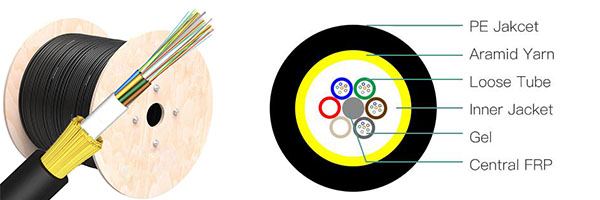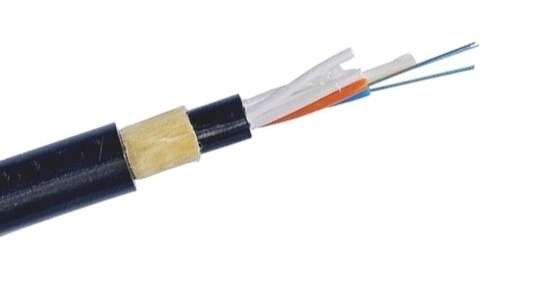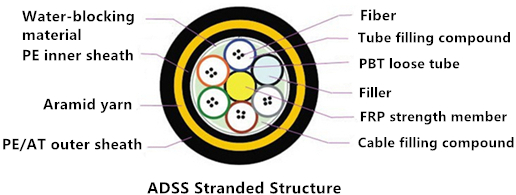ADSS Cable vs. Other Fiber Optic Cables: A Comprehensive Comparison

Understanding ADSS Cable
ADSS cable, also known as an all-dielectric self-supporting fiber optic cable, is a versatile solution for various industries and applications. This type of fiber optic cable is designed to support its own weight without the need for additional support structures like messenger wires. The ADSS cable's core consists of optical fibers that transmit data through light signals.
One of the key advantages of ADSS cable is its ease of installation. Unlike other types of fiber optic cables, ADSS cables are lightweight and self-supporting, making them simpler to deploy. Additionally, they do not require grounding, which reduces installation costs and time.
ADSS cables find extensive use in telecommunications networks, providing reliable connectivity for telephone services, internet connections, and cable TV services. They are also commonly employed in the power utility sector for power line communication and monitoring purposes. The high tensile strength of ADSS cables makes them ideal for installations along power lines.
Key Features and Advantages of ADSS Cable
ADSS cable offers a range of key features and advantages that make it a preferred choice in the field of fiber optic cables.
High Tensile Strength and Durability
ADSS cable is specifically designed to withstand high tension and harsh environmental conditions. Its construction includes a strong outer sheath that provides protection to the delicate fiber optic core. This robust design ensures the long-term reliability of ADSS cable, minimizing the need for frequent maintenance or repairs.
The high tensile strength of ADSS cable allows it to bear significant loads without compromising its performance. It can withstand the forces exerted by wind, ice, and other external factors, making it suitable for installations in areas prone to extreme weather conditions.
Easy and Cost-Effective Installation
One of the major advantages of ADSS cable is its easy installation process. Unlike other types of fiber optic cables, ADSS cables do not require additional support structures like messenger wires. This eliminates the need for extra hardware and simplifies the installation procedure.
The lightweight nature of ADSS cable further contributes to its ease of installation. Its self-supporting design means that it can be installed on existing infrastructure without extensive modifications or reinforcements. Additionally, since ADSS cables do not require grounding, there are cost savings associated with reduced labor and materials.

Comparison with Other Fiber Optic Cables
When comparing ADSS cable with other types of fiber optic cables, it becomes evident that ADSS cable offers distinct advantages in certain scenarios.
ADSS Cable vs. Aerial Fiber Optic Cables
ADSS cable eliminates the need for separate support structures, unlike aerial fiber optic cables. Traditional aerial cables require messenger wires or other means of support to bear their weight. In contrast, ADSS cable is self-supporting, which simplifies the installation process and reduces the overall cost.
Aerial cables are more susceptible to damage from environmental factors such as wind, ice, and wildlife interference. On the other hand, ADSS cable provides better protection due to its durable outer sheath and all-dielectric construction. This makes ADSS cable a reliable choice for installations in areas prone to harsh weather conditions.
The self-supporting design of ADSS cable also makes it more suitable for long-distance installations. It can span across vast distances without requiring additional support structures along the way, offering greater flexibility and cost savings.
ADSS Cable vs. Buried Fiber Optic Cables
Compared to buried fiber optic cables, ADSS cable offers easier and faster installation. Buried cables require extensive digging and trenching to lay them underground, which can be time-consuming and labor-intensive. In contrast, ADSS cable can be installed on existing infrastructure without the need for excavation.
Buried cables are also more susceptible to damage from accidental digging or construction activities. They often require additional protective measures and regular maintenance to ensure their integrity. In comparison, ADSS cable provides a cost-effective solution for areas where burial is not feasible or practical.
Applications and Use Cases of ADSS Cable
ADSS cable finds extensive applications in various industries, thanks to its unique features and advantages.
Telecommunications Industry
In the telecommunications industry, ADSS cable is widely used for long-distance communication networks. It provides reliable connectivity for telephone services, internet connections, and cable TV services. The self-supporting nature of ADSS cable makes it particularly suitable for aerial installations, where it can be easily deployed on existing utility poles or towers. This eliminates the need for costly infrastructure modifications and reduces installation time.
ADSS cable ensures efficient data transmission over long distances, maintaining signal integrity and minimizing signal loss. Its high tensile strength allows it to withstand the forces exerted by wind and environmental factors, ensuring uninterrupted communication services.
Power Utility Sector
The power utility sector also benefits from the use of ADSS cable. It is commonly employed for power line communication and monitoring purposes. ADSS cable enables efficient transmission of data for smart grid systems, facilitating real-time monitoring of power distribution and enabling effective energy management.
Due to its high tensile strength, ADSS cable is ideal for power line installations. It can withstand the mechanical stresses associated with overhead power lines while providing reliable data transmission capabilities. Additionally, the self-supporting design of ADSS cable simplifies installation along existing power infrastructure without requiring additional support structures.

Final Thoughts on ADSS Cable
ADSS cable offers significant advantages over other types of fiber optic cables, making it a preferred choice for various applications. Its all-dielectric self-supporting design eliminates the need for additional support structures, simplifying installation and reducing costs. The high tensile strength and durability of ADSS cable ensure long-term reliability with minimal maintenance requirements.
As the demand for reliable and efficient communication networks continues to grow, ADSS cable plays a crucial role in meeting these needs. Its versatility and suitability for aerial installations make it an ideal solution for telecommunications networks. Additionally, its use in the power utility sector enables efficient data transmission for smart grid systems.
In conclusion, ADSS cable is a reliable, durable, and cost-effective option that offers numerous benefits in terms of installation ease, performance, and long-term reliability.
See Also
The Future of Fiber Optic: Unveiling the Power of Invisible Fiber Cable
Advantages, Applications, and Installation of SC APC Fiber Optic Cables: A Glimpse into the Future
The Future of Fiber Optic Outdoor Terminal Distribution Boxes for FTTx
Demystifying ONU: A Comprehensive Overview of Types and Functions
About US
Follow Us
AnetFiber company's main products are indoor and outdoor optical fiber cables, outdoor waterproof pre-connected fiber-to-the-home products, PLC optical fiber splitters, optical fiber jumpers and pigtails, MTP®/MPO high-density big data product solutions, optical fiber field quick connectors and research and development molding, injection molding and production of optical fiber distribution boxes, optical fiber chassis cabinets, the market has expanded to the world, Europe, America, Asia, the Middle East and Latin America.
Address
Shenzhen City, Baoan District, Yanluo Street, Tangxiayong Community, Yangyong Industrial Road, Tonggangda New Energy Vehicle Park 406
Contacts
+86 199 2655 3586

